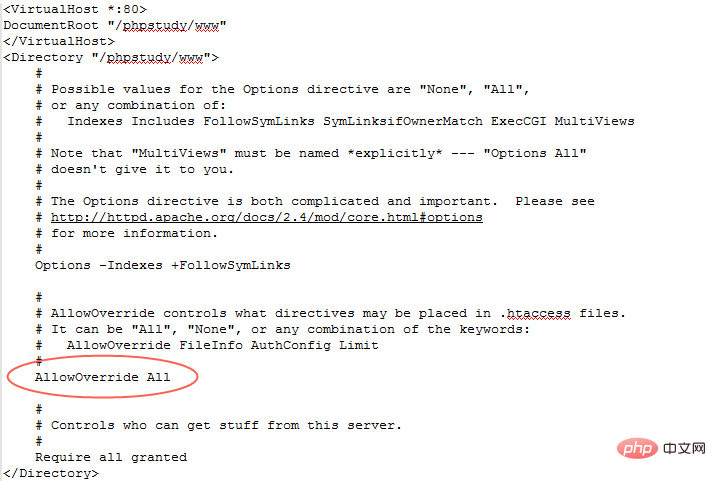Does thinkphp support linux?

准备工作:购买一个linux服务器地址;安装好linux常用的ssh工具(我这边喜欢用xshell敲命令,用filezilla传输文件,这些工具只要到官网下载就好,速度很快的);
1.安装phpstudy for linux
安装下载phpstudy的方式千篇一律,这里简述下就OK。
在xshell中输入:
wget -c http://lamp.phpstudy.net/phpstudy.bin chmod +x phpstudy.bin #权限设置 ./phpstudy.bin #运行安装
安装过程中有php版本和服务器的选择,这些按它的提示选择就行,一段时间(20分钟左右)后就安装好了。
末了,它会告诉你一些phpstudy的操作命令,这些记下就行。
2.导入项目与数据库
phpstudy安装好了之后,在根目录会有一个phpstudy文件夹,如图:

只要将自己的项目通过filezilla传送到/phpstudy/www/目录下就行。
关于数据库的导入,启动phpstudy服务,访问phpstudy自带的数据库管理项目(phpmyadmin)就行,如:http://119.63.131.221/phpmyadmin(119.63.131.221用你自己买的linux地址代替)。导入,导出这里就不赘述了。
相关推荐:《ThinkPHP教程》
3.给予项目文件的访问权限
照理说,到上一步就可以访问了。但linux有保护文件的权限,这时需要设置phpstudy下文件的访问权限,在xshell中敲以下赋权命令:chmod 777 -R /phpstudy
4.apache下隐藏index.php入口
我们在访问tp5项目的时候通常会为了网址的美观而隐藏index.php入口文件的访问。
我这边用的是apache服务器,只要在index.php的同一个目增加.htaccess文件,内容为:
<IfModule mod_rewrite.c>
Options +FollowSymlinks -Multiviews
RewriteEngine on
RewriteCond %{REQUEST_FILENAME} !-d
RewriteCond %{REQUEST_FILENAME} !-f
RewriteRule ^(.*)$ index.php/$1 [QSA,PT,L]
</IfModule>在linux下还要开放apache中的重写URL请求的引擎(mod_rewrite),具体操作如下:
找到:/phpstudy/server/httpd/conf/httpd.conf文件
去掉LoadModule rewrite_module modules/mod_rewrite.so前面的#,并且修改AllowOverride None的值为All,如图:

5.配置域名信息
到了上一步,你会发现,网址还是很长,想通过域名的方式来代替前面一串的访问地址。配置方式也很简单,进入/phpstudy/server/httpd/conf/extra/http-vhost.conf文件,按它上面的例子增加就行,如图:

6.注意事项
通常情况下的工作模式是,先在window上写项目,然后在linux服务器下测试,这样常常会出现一些开发过程中碰不到的问题。这里简单说明下,最主要的还是大小写的区别,所以在开发过程中,view目录下的模块名还是全部小写,驼峰的用下划线分隔,这样可以少许多的麻烦。
The above is the detailed content of Does thinkphp support linux?. For more information, please follow other related articles on the PHP Chinese website!

Hot AI Tools

Undresser.AI Undress
AI-powered app for creating realistic nude photos

AI Clothes Remover
Online AI tool for removing clothes from photos.

Undress AI Tool
Undress images for free

Clothoff.io
AI clothes remover

Video Face Swap
Swap faces in any video effortlessly with our completely free AI face swap tool!

Hot Article

Hot Tools

Notepad++7.3.1
Easy-to-use and free code editor

SublimeText3 Chinese version
Chinese version, very easy to use

Zend Studio 13.0.1
Powerful PHP integrated development environment

Dreamweaver CS6
Visual web development tools

SublimeText3 Mac version
God-level code editing software (SublimeText3)

Hot Topics
 What computer configuration is required for vscode
Apr 15, 2025 pm 09:48 PM
What computer configuration is required for vscode
Apr 15, 2025 pm 09:48 PM
VS Code system requirements: Operating system: Windows 10 and above, macOS 10.12 and above, Linux distribution processor: minimum 1.6 GHz, recommended 2.0 GHz and above memory: minimum 512 MB, recommended 4 GB and above storage space: minimum 250 MB, recommended 1 GB and above other requirements: stable network connection, Xorg/Wayland (Linux)
 Linux Architecture: Unveiling the 5 Basic Components
Apr 20, 2025 am 12:04 AM
Linux Architecture: Unveiling the 5 Basic Components
Apr 20, 2025 am 12:04 AM
The five basic components of the Linux system are: 1. Kernel, 2. System library, 3. System utilities, 4. Graphical user interface, 5. Applications. The kernel manages hardware resources, the system library provides precompiled functions, system utilities are used for system management, the GUI provides visual interaction, and applications use these components to implement functions.
 vscode terminal usage tutorial
Apr 15, 2025 pm 10:09 PM
vscode terminal usage tutorial
Apr 15, 2025 pm 10:09 PM
vscode built-in terminal is a development tool that allows running commands and scripts within the editor to simplify the development process. How to use vscode terminal: Open the terminal with the shortcut key (Ctrl/Cmd). Enter a command or run the script. Use hotkeys (such as Ctrl L to clear the terminal). Change the working directory (such as the cd command). Advanced features include debug mode, automatic code snippet completion, and interactive command history.
 How to check the warehouse address of git
Apr 17, 2025 pm 01:54 PM
How to check the warehouse address of git
Apr 17, 2025 pm 01:54 PM
To view the Git repository address, perform the following steps: 1. Open the command line and navigate to the repository directory; 2. Run the "git remote -v" command; 3. View the repository name in the output and its corresponding address.
 How to run java code in notepad
Apr 16, 2025 pm 07:39 PM
How to run java code in notepad
Apr 16, 2025 pm 07:39 PM
Although Notepad cannot run Java code directly, it can be achieved by using other tools: using the command line compiler (javac) to generate a bytecode file (filename.class). Use the Java interpreter (java) to interpret bytecode, execute the code, and output the result.
 Where to write code in vscode
Apr 15, 2025 pm 09:54 PM
Where to write code in vscode
Apr 15, 2025 pm 09:54 PM
Writing code in Visual Studio Code (VSCode) is simple and easy to use. Just install VSCode, create a project, select a language, create a file, write code, save and run it. The advantages of VSCode include cross-platform, free and open source, powerful features, rich extensions, and lightweight and fast.
 The difference between laravel and thinkphp
Apr 18, 2025 pm 01:09 PM
The difference between laravel and thinkphp
Apr 18, 2025 pm 01:09 PM
Laravel and ThinkPHP are both popular PHP frameworks and have their own advantages and disadvantages in development. This article will compare the two in depth, highlighting their architecture, features, and performance differences to help developers make informed choices based on their specific project needs.
 What is the main purpose of Linux?
Apr 16, 2025 am 12:19 AM
What is the main purpose of Linux?
Apr 16, 2025 am 12:19 AM
The main uses of Linux include: 1. Server operating system, 2. Embedded system, 3. Desktop operating system, 4. Development and testing environment. Linux excels in these areas, providing stability, security and efficient development tools.






